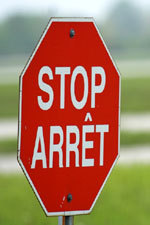Driving in Canada
 |
Driving in Canada
By John Heilig
After returning from a two-week driving vacation through Eastern Canada, I feel eminently qualified to comment on negotiating the streets and highways of our northern neighbor. It’s not that Canadians drive on the wrong side of the road or anything (that would be too weird), it’s just that driving is different.
First, Canadians operate on the metric system, so when you see a speed limit sign, like “Maximum 110”, it doesn’t mean 110 mph, but more like 68 mph. Fortunately, our 2001 Buick had a switch to convert from English (American) to metric, so it wasn’t a problem. I did miss traveling at 110 when we got home, though.
Sadly, on some of the roads that seem to go on forever and you can see the perspective lines meet off in the distance, the top speed is 120 kph, which is a measly 73 mph. Fortunately, most Canadian drivers either can’t read or have decided that some of these numbers don’t make sense and drive 10-15 kph over the limit (still only 6-9 mph).
Our magic switch also “translated” the exterior temperature readout from Fahrenheit to Celsius. That helped, because on the radio they only talked about Celsius. They also said there was a forecast of 10 millimeters of rain (what’s that?).
The other problem is the signs. Since Canada has two official languages, all (well, most) signs are in English and French. It’s a good way to brush up on your French, but for the driver, “Arret” means “Stop” and I’m not really sure what the others are. My wife took French and she translated some of them. I was impressed, though, with how they can sometimes put both languages in the same line. For example, a sign that might read “Rue Main St” means Rue Main in French and Main Street in English.
I tried to explain the dual language situation, but on Cape Breton Island in Nova Scotia it becomes even more challenging. The Bretonese go along with the dual language thing, but with the Gaelic/Scottish/Irish heritage of many of the inhabitants, they also have signs in Gaelic. To make matters less confusing, they only have English and Gaelic, which I’m sure upsets the Quebecoise.
I didn’t leave with the best impression of Canadian English spelling, either. They have problems (like the British) with e’s and r’s. It’s center, not centre, folks. And theater, not theatre (oops, we do that one, too.) And you wouldn’t believe what they do to maneuver (maneouvre). It’s all a lot of manouere to me.
In Prince Edward Island, the traffic engineers have come up with the best traffic light plan known to man, or at least this man. Green lights are round, which is normal. Yellow lights, however, are diamond-shaped, and they do stand out. Red lights are square and slightly larger. When they’re arrayed above each other (or below each other) they’re interesting, but when they’re arrayed side-by-side they almost look like a Christmas display.
I grew up in New York City and now live in Pennsylvania. In both locations the driver has the right-of-way, or at least believes he has the r-o-w. All over Canada it’s the other way around. If a pedestrian even looks as if he’s going to cross the street, all traffic stops. If you’re halfway through an intersection and some idiot decides he wants to cross the street, you’re the bad guy. Even if you have the green light and they have the upraised red hand light, they’ll still try to cross and have the r-o-w. It’s enough to piss off the Pope.
The other side of the coin, of course, is that all this courtesy is extended to other drivers as well. If you’re looking to pull out onto a road and you even see another car headed your way, you wait. A lot of this is a “what’s the rush?” attitude, but it also makes for fewer near-crashes, more smiles and lower blood pressure.
In two weeks of driving through Eastern Canada, we saw – maybe – one piece of litter. Hey, I’ve driven in NYC and Philly, where you sometimes can’t see the streets themselves because of all the garbage. I don’t know how they do it, but they do. Nor were the highways littered with “No Littering” signs and billboards were at a minimum. We came back into Maine and sometimes it was difficult seeing the forest for the billboard “trees.”
The ultimate destination of our trip was Prince Edward Island (Ile du Prince Edouard), where we had spent part of our honeymoon 46 years ago. Back then, the only way to get to PEI was by ferry. This time, we ferried from Nova Scotia (Latin for New Scotland, or Nieuw Ecosse in French) to the Island to get there, but to get off we had one of the most diabolical tortures I’ve encountered. Replacing the ferry from New Brunswick (Nieuw Brunswick) is the Confederation Bridge, an eight-mile long stretch of concrete that was completed in 1997 at a cost of $1 billion. I’m not a great fan of bridges to begin with, but this thing had me white-knuckling it all the way. Halfway across (and still not yet at the top of the span) I caught sight of an anemometer (wind gauge) on one of the light poles, and it was spinning madly out of control. The concrete sides of the bridge held back the wind (and also screwed up the view if you were brave enough to look), but that anemometer was in my mind the rest of the way. I can’t remember when I was so thrilled to be back on land again.
Driving in Canada can be a challenge, but with all the courtesy, it’s also fun. Fewer drivers clogging up the roads also help the amicability of the situation.
© 2009 The Auto Page Syndicate


